
|
It returns for the first time in 70 years. It will brighten up to 4.5 mag in spring. Now it is 7.0 mag (Feb. 27, Osamu Miyazaki). It will turn to fade out rapidly after brightening. In the Northern Hemisphere, it will be unobservable in April. In the Southern Hemisphere, it is not observable now, but it will appear in April.
Date(TT) R.A. (2000) Decl. Delta r Elong. m1 Best Time(A, h)
Mar. 2 23 43.53 35 30.2 1.685 1.198 44 7.2 19:20 (122, 17)
Mar. 9 0 19.22 33 35.3 1.654 1.111 40 6.7 19:26 (120, 16)
|
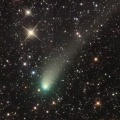
|
Now it is 9.7 mag (Feb. 21, Taras Prystavski). Fading gradually. In the Northern Hemisphere, it stays observable in good condition. In the Southern Hemisphere, it will be getting lower gradually after this, and it will be unobservable in May.
Date(TT) R.A. (2000) Decl. Delta r Elong. m1 Best Time(A, h)
Mar. 2 18 13.31 -4 45.8 1.322 1.342 69 9.1 5:04 (311, 37)
Mar. 9 18 32.61 1 25.4 1.303 1.365 71 9.1 4:55 (306, 41)
|
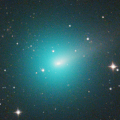
|
It brightened up to 7.4 mag from December to January (Dec. 24, Osamu Miyazaki). Now it is 8.9 mag (Feb. 13, Chris Wyatt). It will fade out rapidly after this. It will be fainter than 18 mag in June. It stays observable in good condition.
Date(TT) R.A. (2000) Decl. Delta r Elong. m1 Best Time(A, h)
Mar. 2 12 35.72 10 17.3 0.541 1.497 154 9.9 1:57 ( 0, 65)
Mar. 9 12 30.26 10 23.3 0.567 1.540 161 10.4 1:24 ( 0, 65)
|

|
Now it is 10.9 mag (Feb. 27, Osamu Miyazaki). It will fade out rapidly after this. It stays observable in good condition.
Date(TT) R.A. (2000) Decl. Delta r Elong. m1 Best Time(A, h)
Mar. 2 5 36.98 17 27.9 0.874 1.460 102 10.3 19:20 ( 18, 72)
Mar. 9 5 58.83 17 36.6 0.929 1.484 101 10.5 19:26 ( 26, 71)
|
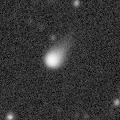
|
It will approach to Sun down to 0.4 a.u. in late September, and it is expected to brighten up to 0 mag. Now it is 12.7 mag (Feb. 15, ATLAS Chile). It will brighten rapidly after this. It stays observable in good condition. At the high light, in the Northern Hemisphere, it will be observable in good condition after the perihelion passage. In the Southern Hemisphere, it will be observable in the low sky before and after the perihelion passage.
Date(TT) R.A. (2000) Decl. Delta r Elong. m1 Best Time(A, h)
Mar. 2 15 5.29 -7 18.1 2.998 3.535 115 12.4 4:26 ( 0, 48)
Mar. 9 15 0.68 -6 56.3 2.803 3.449 123 12.1 3:54 ( 0, 48)
|
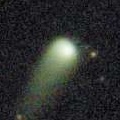
|
Now it is 12.8 mag (Feb. 18, Ken-ichi Kadota). It stays 13 mag for a while. It will be unobservable in June.
Date(TT) R.A. (2000) Decl. Delta r Elong. m1 Best Time(A, h)
Mar. 2 7 31.40 26 15.0 3.367 4.061 128 12.4 20:49 ( 0, 81)
Mar. 9 7 21.94 27 20.4 3.453 4.035 119 12.5 20:12 ( 0, 82)
|

|
First return of a new periodic comet which brightened up to 10 mag in 2001. Now it is 13.1 mag (Feb. 18, Ken-ichi Kadota). It will fade out rapidly after this. It will be fainter than 18 mag in June. It locates somewhat low in the Northern Hemisphere. In the Southern Hemisphere, it will never be observable after this.
Date(TT) R.A. (2000) Decl. Delta r Elong. m1 Best Time(A, h)
Mar. 2 0 25.38 31 49.9 1.922 1.407 44 12.7 19:20 (115, 22)
Mar. 9 0 39.02 35 57.0 1.936 1.414 44 12.7 19:26 (121, 21)
|

|
Now it is 14.0 mag (Feb. 16, Hiroshi Abe). Fading slowly. In the Northern Hemisphere, it will be unobservable in June. In the Southern Hemisphere, it stays observable in good condition. It is fainter than this ephemeris recently.
Date(TT) R.A. (2000) Decl. Delta r Elong. m1 Best Time(A, h)
Mar. 2 14 44.91 -32 46.9 2.165 2.695 111 12.9 4:06 ( 0, 22)
Mar. 9 14 26.01 -34 49.6 2.045 2.693 120 12.8 3:20 ( 0, 20)
|

|
Now it is 13.8 mag (Feb. 12, Hiroshi Abe). It will fade out rapidly after this. It will be fainter than 18 mag in May. It stays observable in good condition. Vladimir Bezugly reported it was visible at around 12 mag in the SOHO LASCO images in late January.
Date(TT) R.A. (2000) Decl. Delta r Elong. m1 Best Time(A, h)
Mar. 2 5 32.66 -14 8.0 0.222 1.045 98 12.9 19:20 ( 8, 41)
Mar. 9 6 49.37 -10 12.3 0.224 1.095 111 13.1 19:44 ( 0, 45)
|
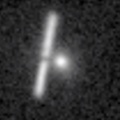
|
It returned for the first time in 68 years. It will brighten up to 7.5 mag in summer. Now it is 13.1 mag (Feb. 14, Alan Hale). It will brighten rapidly after this. In the Northern Hemisphere, it will be getting lower gradually. In the Southern Hemisphere, it will be unobservable in April. At the high light, it locates low in the Northern Hemisphere, or it is not observable in the Southern Hemisphere.
Date(TT) R.A. (2000) Decl. Delta r Elong. m1 Best Time(A, h)
Mar. 2 3 5.75 4 30.2 2.303 2.076 64 13.3 19:20 ( 64, 39)
Mar. 9 3 12.14 7 0.8 2.314 2.003 59 13.0 19:26 ( 72, 36)
|

|
It was observed at 9-10 mag for a long time in 2023. Now it is 12.6 mag (Feb. 2, Chris Wyatt). It stays 14 mag for a while. In the Northern Hemisphere, it will never be observable after this. In the Southern Hemisphere, it will be getting higher gradually.
Date(TT) R.A. (2000) Decl. Delta r Elong. m1 Best Time(A, h)
Mar. 2 23 45.53 -39 25.8 4.698 3.920 34 13.3 19:20 ( 58,-24)
Mar. 9 23 50.23 -39 31.0 4.740 3.977 35 13.4 19:26 ( 60,-29)
|

|
Now it is 14.7 mag (Feb. 13, Chris Wyatt). In the Northern Hemisphere, it will be getting lower gradually after this, and it will be unobservable in July. In the Southern Hemisphere, it stays observable in good condition.
Date(TT) R.A. (2000) Decl. Delta r Elong. m1 Best Time(A, h)
Mar. 2 8 7.82 21 29.4 5.411 6.183 137 13.6 21:25 ( 0, 76)
Mar. 9 8 6.02 21 28.7 5.493 6.184 130 13.6 20:56 ( 0, 76)
|

|
It brightened up to 8 mag from 2022 summer to 2023 spring. Now it is 13.2 mag (Feb. 13, Chris Wyatt). Fading slowly. It will be getting lower gradually after this, and it will be unobservable in May in the Northern Hemisphere, or in June in the Southern Hemisphere.
Date(TT) R.A. (2000) Decl. Delta r Elong. m1 Best Time(A, h)
Mar. 2 5 6.10 5 58.2 4.978 5.147 94 13.7 19:20 ( 27, 58)
Mar. 9 5 6.30 6 51.8 5.153 5.208 87 13.8 19:26 ( 41, 55)
|

|
Now it is 14.0 mag (Feb. 16, Hiroshi Abe). It stays 14 mag for a while. It locates somewhat low in the Northern Hemisphere. But it will become high in winter. In the Southern Hemisphere, it stays observable in good condition.
Date(TT) R.A. (2000) Decl. Delta r Elong. m1 Best Time(A, h)
Mar. 2 12 10.43 -38 28.8 4.493 5.194 130 13.9 1:31 ( 0, 16)
Mar. 9 12 8.17 -38 4.3 4.421 5.180 135 13.9 1:02 ( 0, 17)
|
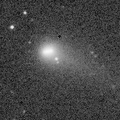
|
Now it is 13.8 mag (Feb. 13, Chris Wyatt). It stays 15 mag for a while. In the Northern Hemisphere, it stays observable in good condition. It stays extremely low in the Southern Hemisphere. But it will become high in winter.
Date(TT) R.A. (2000) Decl. Delta r Elong. m1 Best Time(A, h)
Mar. 2 3 45.61 25 37.1 2.031 2.073 78 14.0 19:20 ( 82, 60)
Mar. 9 3 58.81 26 28.3 2.090 2.060 74 14.0 19:26 ( 87, 56)
|

|
Now it is 13.9 mag (Feb. 2, Chris Wyatt). Fading slowly. In the Northern Hemisphere, it will be unobservable in May. In the Southern Hemisphere, it stays observable in good condition.
Date(TT) R.A. (2000) Decl. Delta r Elong. m1 Best Time(A, h)
Mar. 2 8 8.13 -44 10.4 4.164 4.694 116 14.0 21:24 ( 0, 11)
Mar. 9 7 57.41 -43 13.4 4.235 4.731 114 14.1 20:46 ( 0, 12)
|

|
It brightened up to 7.8 mag in late July (July 20, Thomas Lehmann). Now it is 15.8 mag (Feb. 21, Thomas Lehmann). Fading gradually. It stays observable in good condition.
Date(TT) R.A. (2000) Decl. Delta r Elong. m1 Best Time(A, h)
Mar. 2 14 25.97 8 59.5 2.432 3.130 127 14.4 3:47 ( 0, 64)
Mar. 9 14 12.68 11 18.2 2.408 3.200 136 14.5 3:06 ( 0, 66)
|

|
It brightened up to 8.3 mag in 2021-2022 winter (Jan. 6, 2022, Toshiyuki Takahashi). Now it is 14.0 mag (Feb. 16, G. Duszanowicz). It stays 15 mag for a while. In the Northern Hemisphere, it will be unobservable in May. In the Southern Hemisphere, it stays observable in good condition.
Date(TT) R.A. (2000) Decl. Delta r Elong. m1 Best Time(A, h)
Mar. 2 11 4.07 -54 7.0 6.898 7.423 118 14.5 0:25 ( 0, 1)
Mar. 9 10 59.55 -54 7.1 6.905 7.469 121 14.5 23:49 ( 0, 1)
|

|
The condition is bad in this apparition. It brightens up to 10 mag in early summer, however, it is not observable at all. Brightening rapidly. It will never be observable after this.
Date(TT) R.A. (2000) Decl. Delta r Elong. m1 Best Time(A, h)
Mar. 2 23 57.28 -7 52.3 2.385 1.460 16 15.1 19:20 ( 84, -5)
Mar. 9 0 16.30 -5 29.0 2.342 1.403 14 14.6 19:26 ( 88, -7)
|

|
First return of a new periodic comet which was discovered in 2011, half a year after the perihelion passage. Now it is 14.6 mag (Feb. 18, Ken-ichi Kadota). It stays 15 mag for a while. It stays observable in good condition.
Date(TT) R.A. (2000) Decl. Delta r Elong. m1 Best Time(A, h)
Mar. 2 7 46.38 2 35.6 0.644 1.509 133 14.8 21:04 ( 0, 57)
Mar. 9 7 42.15 0 35.8 0.636 1.460 125 14.7 20:32 ( 0, 55)
|
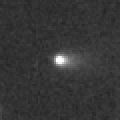
|
It is expected to brighten up to 12 mag in early summer. Now it is 14.8 mag (Feb. 24, ATLAS South Africa). Brightening gradually. It locates somewhat low in the Northern Hemisphere. In the Southern Hemisphere, it will be unobservable in April. At the high light, it is not observable in the Southern Hemisphere, or it locates low in the Northern Hemisphere.
Date(TT) R.A. (2000) Decl. Delta r Elong. m1 Best Time(A, h)
Mar. 2 2 15.30 -4 52.2 2.236 1.780 50 15.0 19:20 ( 65, 24)
Mar. 9 2 21.14 -1 3.7 2.238 1.703 45 14.8 19:26 ( 73, 21)
|

|
It approached to Earth down to 0.38 a.u., and brightened up to 8.0 mag in autumn (Sept. 29, Virgilio Gonano). Now it is 14.5 mag (Feb. 9, Toshihiko Ikemura, Hirohisa Sato). Fading rapidly. It will be fainter than 18 mag in May. It stays observable in good condition.
Date(TT) R.A. (2000) Decl. Delta r Elong. m1 Best Time(A, h)
Mar. 2 7 59.85 -2 52.0 1.208 2.040 135 14.8 21:18 ( 0, 52)
Mar. 9 8 1.57 -1 26.6 1.315 2.101 130 15.2 20:52 ( 0, 54)
|
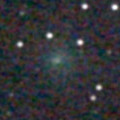
|
It must have brightened up to 11 mag in winter. However, it was too low to observe at the high light. Now it is 13.7 mag (Feb. 19, Michael Mattiazzo). Fading rapidly. It will be fainter than 18 mag in April. In the Northern Hemisphere, it will be getting higher gradually. In the Southern Hemisphere, it stays observable in good condition.
Date(TT) R.A. (2000) Decl. Delta r Elong. m1 Best Time(A, h)
Mar. 2 19 33.75 -29 45.4 1.434 1.128 51 14.9 5:04 (312, 5)
Mar. 9 19 19.00 -27 50.4 1.320 1.211 61 15.6 4:55 (317, 12)
|
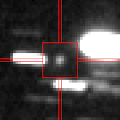
|
It is expected to brighten up to 12.5 mag in summer. Now it is 15.8 mag (Feb. 7, Thomas Lehmann). Brightening gradually. In the Northern Hemisphere, it is not observable now. In the Southern Hemisphere, it stays observable in good condition. Around the high light, it is observable in good condition in the Southern Hemisphere, but it locates very low in the Northern Hemisphere.
Date(TT) R.A. (2000) Decl. Delta r Elong. m1 Best Time(A, h)
Mar. 2 16 6.01 -69 44.7 3.559 3.647 87 15.4 5:04 (358,-15)
Mar. 9 16 17.92 -70 52.4 3.444 3.594 90 15.2 4:55 (359,-16)
|

|
It brightened up to 12.1 mag in 2023 spring (May 20, Jose Guilherme de S. Aguiar). Now it is 15.0 mag (Feb. 13, Chris Wyatt). Fading slowly. In the Northern Hemisphere, it is not observable now. In the Southern Hemisphere, it stays observable in good condition.
Date(TT) R.A. (2000) Decl. Delta r Elong. m1 Best Time(A, h)
Mar. 2 4 8.73 -62 6.0 4.263 4.181 78 15.3 19:20 ( 13,-10)
Mar. 9 4 15.50 -59 41.3 4.313 4.224 78 15.4 19:26 ( 17, -9)
|
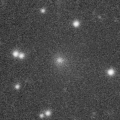
|
Now it is 15.7 mag (Feb. 16, Taras Prystavski). It will fade out rapidly after this. It will be fainter than 18 mag in June. In the Northern Hemisphere, it will be getting higher gradually. In the Southern Hemisphere, it stays observable in good condition.
Date(TT) R.A. (2000) Decl. Delta r Elong. m1 Best Time(A, h)
Mar. 2 17 5.96 -39 42.6 1.314 1.542 82 15.5 5:04 (344, 13)
Mar. 9 17 6.43 -35 4.5 1.224 1.573 89 15.4 4:55 (346, 18)
|
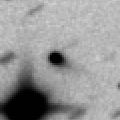
|
Now it is 14.7 mag (Feb. 12, Yukihiro Sugiyama). It will fade out rapidly after this. It will be fainter than 18 mag in May. In the Northern Hemisphere, it stays observable in good condition. It locates somewhat low in the Southern Hemisphere. But it will become high in spring.
Date(TT) R.A. (2000) Decl. Delta r Elong. m1 Best Time(A, h)
Mar. 2 7 37.09 36 23.9 0.823 1.625 126 15.5 20:56 (180, 89)
Mar. 9 7 45.65 35 10.7 0.859 1.624 122 15.5 20:37 (180, 90)
|
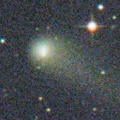
|
It brightened up to 11.1 mag in early 2022 (Mar. 31, 2022, F. Kugel, J.-G. Bosch, J. Nicolas). Now it is 15.0 mag (Feb. 16, Hiroshi Abe). It stays 16 mag for a while. In the Northern Hemisphere, it stays observable in good condition. It locates somewhat low in the Southern Hemisphere.
Date(TT) R.A. (2000) Decl. Delta r Elong. m1 Best Time(A, h)
Mar. 2 17 40.15 22 37.7 6.643 6.575 81 15.5 5:04 (288, 62)
Mar. 9 17 42.71 23 31.4 6.607 6.615 86 15.6 4:55 (291, 65)
|

|
It will be observable at 15-16 mag from 2024 to 2025. Now it is 17.0 mag (Feb. 20, ATLAS-HKO, Haleakala). It stays 16 mag for a while. It stays observable in good condition.
Date(TT) R.A. (2000) Decl. Delta r Elong. m1 Best Time(A, h)
Mar. 2 13 16.11 2 31.9 2.782 3.629 143 15.8 2:37 ( 0, 57)
Mar. 9 13 13.29 2 54.9 2.712 3.614 151 15.7 2:07 ( 0, 58)
|
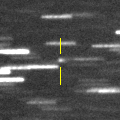
|
It is expected to brighten up to 15.5 mag from March to April. Now it is 16.8 mag (Feb. 12, ATLAS-HKO, Haleakala). Fading slowly. It locates somewhat low in the Northern Hemisphere. But it will become high in spring. In the Southern Hemisphere, it stays observable in good condition.
Date(TT) R.A. (2000) Decl. Delta r Elong. m1 Best Time(A, h)
Mar. 2 18 17.15 -13 53.8 1.599 1.528 67 15.9 5:04 (316, 29)
Mar. 9 18 38.28 -13 21.5 1.560 1.527 69 15.8 4:55 (315, 29)
|

|
Now it is 15.9 mag (Feb. 19, ATLAS Chile). It stays 16 mag for a while. It will be getting lower gradually after this, and it will be unobservable in May in the Northern Hemisphere, or in June in the Southern Hemisphere. But it will be observable again in June in the Southern Hemisphere.
Date(TT) R.A. (2000) Decl. Delta r Elong. m1 Best Time(A, h)
Mar. 2 4 31.34 -6 14.5 6.826 6.797 84 15.8 19:20 ( 32, 44)
Mar. 9 4 33.21 -5 31.1 6.897 6.768 78 15.8 19:26 ( 42, 40)
|
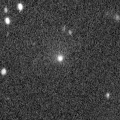
|
Very large comet. It is expected to brighten up to 13 mag in 2031. Now it is 15.8 mag (Feb. 8, Thomas Lehmann). It stays 16 mag for a while. In the Northern Hemisphere, it is not observable now. In the Southern Hemisphere, it stays observable in good condition. In the Northern Hemisphere, it is not observable until 2030.
Date(TT) R.A. (2000) Decl. Delta r Elong. m1 Best Time(A, h)
Mar. 2 2 56.97 -62 52.8 16.936 16.636 70 15.9 19:20 ( 20,-15)
Mar. 9 2 59.13 -62 36.0 16.914 16.611 70 15.8 19:26 ( 23,-17)
|
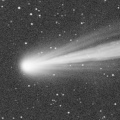
|
It approached to Sun down to 0.23 a.u. and brightened up to 2.5 mag in mid September (Sept. 18, Juan Jose Gonzalez). Now it is 17.0 mag (Feb. 13, ATLAS South Africa). It will fade out rapidly after this. It will be fainter than 18 mag in May. It stays extremely low in the Northern Hemisphere. In the Southern Hemisphere, it stays observable in good condition. Thomas Lehmann reported it was bright as 14.1 mag on Feb. 4.
Date(TT) R.A. (2000) Decl. Delta r Elong. m1 Best Time(A, h)
Mar. 2 8 50.92 -51 19.8 2.534 3.099 115 15.9 22:07 ( 0, 4)
Mar. 9 8 37.03 -48 54.5 2.625 3.190 116 16.1 21:26 ( 0, 6)
|
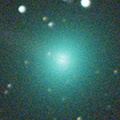
|
It approached to Earth down to 0.2 a.u. in early November, and brightened up to 6.2 mag (Nov. 11, Marco Goiato). Fading gradually. It will be fainter than 18 mag in May. In the Northern Hemisphere, it will never be observable after this. It locates somewhat low in the Southern Hemisphere.
Date(TT) R.A. (2000) Decl. Delta r Elong. m1 Best Time(A, h)
Mar. 2 0 27.60 -44 19.6 2.820 2.195 42 16.0 19:20 ( 49,-19)
Mar. 9 0 37.37 -44 44.1 2.893 2.283 43 16.2 19:26 ( 51,-23)
|
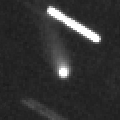
|
Now it is 16.1 mag (Feb. 22, ATLAS Chile). It stays 16 mag for a while. It stays extremely low in the Northern Hemisphere. It locates somewhat low in the Southern Hemisphere. But it will become high in summer. The brightness evolution is slower than originally expected.
Date(TT) R.A. (2000) Decl. Delta r Elong. m1 Best Time(A, h)
Mar. 2 1 53.81 -30 47.7 3.671 3.105 48 16.0 19:20 ( 49, 2)
Mar. 9 1 58.88 -30 54.2 3.678 3.074 46 16.0 19:26 ( 53, -2)
|
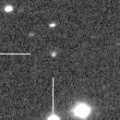
|
Now it is 16.4 mag (Feb. 12, Ken-ichi Kadota). It stays 16 mag for a while. It locates somewhat low in the Northern Hemisphere. But it will become high in summer. In the Southern Hemisphere, it stays observable in good condition.
Date(TT) R.A. (2000) Decl. Delta r Elong. m1 Best Time(A, h)
Mar. 2 14 13.19 -28 49.5 2.848 3.447 119 16.3 3:34 ( 0, 26)
Mar. 9 14 14.85 -28 43.9 2.771 3.450 126 16.3 3:08 ( 0, 26)
|
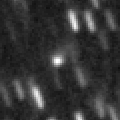
|
Now it is 17.4 mag (Feb. 20, ATLAS Chile). It stays 16 mag for a while. It stays extremely low in the Northern Hemisphere. In the Southern Hemisphere, it stays observable in good condition.
Date(TT) R.A. (2000) Decl. Delta r Elong. m1 Best Time(A, h)
Mar. 2 16 50.76 -47 26.0 5.778 5.775 84 16.4 5:04 (349, 6)
Mar. 9 16 47.20 -48 12.1 5.636 5.753 91 16.4 4:55 (352, 6)
|

|
It brightened up to 13 mag in early 2023. It stays 17 mag for a while. It stays extremely low in the Northern Hemisphere. In the Southern Hemisphere, it stays observable in good condition.
Date(TT) R.A. (2000) Decl. Delta r Elong. m1 Best Time(A, h)
Mar. 2 16 36.74 -47 46.1 3.893 3.969 87 16.4 5:04 (351, 6)
Mar. 9 16 36.30 -47 37.9 3.843 4.029 93 16.4 4:55 (354, 7)
|
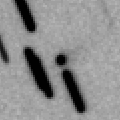
|
Now it is 15.8 mag (Feb. 13, Yukihiro Sugiyama). Fading gradually. It will be fainter than 18 mag in May. It stays observable in good condition.
Date(TT) R.A. (2000) Decl. Delta r Elong. m1 Best Time(A, h)
Mar. 2 8 38.22 -16 29.4 0.873 1.749 139 16.5 21:55 ( 0, 38)
Mar. 9 8 37.28 -16 40.3 0.897 1.746 134 16.6 21:27 ( 0, 38)
|

|
Now it is 16.1 mag (Feb. 11, ATLAS-MLO, Mauna Loa). It will fade out rapidly after this. It will be fainter than 18 mag in April. In the Northern Hemisphere, it will be getting lower gradually. In the Southern Hemisphere, it will be unobservable soon.
Date(TT) R.A. (2000) Decl. Delta r Elong. m1 Best Time(A, h)
Mar. 2 2 9.88 21 34.0 2.233 1.876 56 16.5 19:20 ( 92, 38)
Mar. 9 2 22.25 24 14.4 2.318 1.898 53 16.7 19:26 ( 97, 35)
|
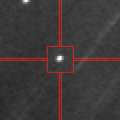
|
Now it is 17.2 mag (Feb. 24, ATLAS Chile). Fading slowly. In the Northern Hemisphere, it is not observable now, but it will be observable soon. In the Southern Hemisphere, it will be getting lower gradually after this, and it will be unobservable in June. But it will be observable again in March.
Date(TT) R.A. (2000) Decl. Delta r Elong. m1 Best Time(A, h)
Mar. 2 6 20.35 -74 33.7 1.768 2.008 88 16.8 19:34 ( 0,-19)
Mar. 9 5 51.06 -67 11.2 1.730 1.980 89 16.7 19:26 ( 5,-12)
|

|
It will brighten up to 15 mag from summer to autumn. Brightening slowly. In the Northern Hemisphere, it is not observable now, but it will appear in April. It locates somewhat low in the Southern Hemisphere. But it will become high in spring.
Date(TT) R.A. (2000) Decl. Delta r Elong. m1 Best Time(A, h)
Mar. 2 20 57.25 -20 23.1 2.643 1.862 30 16.8 5:04 (293, -3)
Mar. 9 21 16.06 -19 15.3 2.600 1.850 33 16.7 4:55 (292, -2)
|
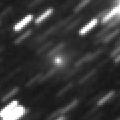
|
Very far object. Now it is 17.0 mag (Jan. 27, ATLAS Chile). It stays 17 mag for a while. In the Northern Hemisphere, it is not observable now.
Date(TT) R.A. (2000) Decl. Delta r Elong. m1 Best Time(A, h)
Mar. 2 2 13.67 -67 43.4 10.640 10.329 69 16.8 19:20 ( 20,-21)
Mar. 9 2 15.41 -67 0.6 10.638 10.331 69 16.8 19:26 ( 23,-23)
|

|
Now it is 17.0 mag (Feb. 24, D. Buczynski). It stays 17 mag for a while. It will be unobservable in May.
Date(TT) R.A. (2000) Decl. Delta r Elong. m1 Best Time(A, h)
Mar. 2 4 42.18 27 59.0 4.843 4.964 91 16.9 19:20 ( 73, 72)
Mar. 9 4 45.81 27 28.7 4.938 4.952 84 16.9 19:26 ( 80, 66)
|
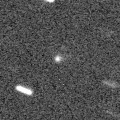
|
Now it is 17.0 mag (Feb. 9, Toshihiko Ikemura, Hirohisa Sato). Brightening slowly. It will be unobservable in May.
Date(TT) R.A. (2000) Decl. Delta r Elong. m1 Best Time(A, h)
Mar. 2 2 25.01 8 7.2 2.749 2.332 55 17.0 19:20 ( 75, 34)
Mar. 9 2 35.81 9 19.0 2.785 2.297 51 16.9 19:26 ( 80, 30)
|
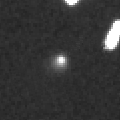
|
Now it is 16.9 mag (Feb. 25, ATLAS Chile). It stays 17 mag for a while. In the Northern Hemisphere, it will be unobservable in April. In the Southern Hemisphere, it stays observable in good condition.
Date(TT) R.A. (2000) Decl. Delta r Elong. m1 Best Time(A, h)
Mar. 2 4 48.70 -34 1.2 7.507 7.491 85 17.0 19:20 ( 16, 19)
Mar. 9 4 50.67 -33 8.5 7.546 7.470 81 17.0 19:26 ( 23, 18)
|

|
Now it is 16.8 mag (Feb. 22, ATLAS-HKO, Haleakala). It stays 17 mag for a while. It will be unobservable in April in the Southern Hemisphere, or in June in the Northern Hemisphere.
Date(TT) R.A. (2000) Decl. Delta r Elong. m1 Best Time(A, h)
Mar. 2 4 38.25 39 38.0 6.593 6.700 91 17.1 19:20 (112, 73)
Mar. 9 4 41.30 39 28.1 6.702 6.703 85 17.2 19:26 (110, 67)
|

|
Now it is 16.8 mag (Feb. 16, Catalina Sky Survey). It will fade out rapidly after this. It will be fainter than 18 mag in April. It locates somewhat low in the Northern Hemisphere. In the Southern Hemisphere, it will be unobservable soon.
Date(TT) R.A. (2000) Decl. Delta r Elong. m1 Best Time(A, h)
Mar. 2 1 39.73 13 46.6 2.789 2.228 46 17.2 19:20 ( 88, 28)
Mar. 9 1 54.50 14 58.5 2.864 2.248 43 17.3 19:26 ( 92, 25)
|
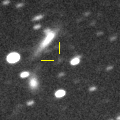
|
Now it is 17.1 mag (Feb. 7, Toshihiko Ikemura, Hirohisa Sato). It stays 17 mag for a while. It locates somewhat low in the Northern Hemisphere. In the Southern Hemisphere, it stays observable in good condition.
Date(TT) R.A. (2000) Decl. Delta r Elong. m1 Best Time(A, h)
Mar. 2 15 52.23 -29 2.0 2.855 3.171 99 17.3 5:04 (358, 26)
Mar. 9 15 56.56 -29 20.4 2.758 3.168 105 17.2 4:49 ( 0, 26)
|
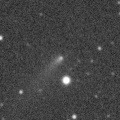
|
It brightened very rapidly up to 14.9 mag in early summer (July 13, Taras Prystavski). Now it is 17.2 mag (Jan. 16, Ken-ichi Kadota). Fading gradually. It will be fainter than 18 mag in April. In the Northern Hemisphere, it stays observable in good condition. It locates somewhat low in the Southern Hemisphere.
Date(TT) R.A. (2000) Decl. Delta r Elong. m1 Best Time(A, h)
Mar. 2 14 25.29 25 11.6 2.192 2.889 126 17.2 3:46 ( 0, 80)
Mar. 9 14 11.34 29 12.2 2.184 2.944 132 17.3 3:05 ( 0, 84)
|

|
Now it is 17.1 mag (Feb. 13, Ken-ichi Kadota). It stays 17 mag for a while. In the Northern Hemisphere, it will be getting lower gradually after this, and it will be unobservable in June. In the Southern Hemisphere, it stays observable in good condition.
Date(TT) R.A. (2000) Decl. Delta r Elong. m1 Best Time(A, h)
Mar. 2 7 44.46 -8 44.8 3.892 4.599 130 17.3 21:02 ( 0, 46)
Mar. 9 7 43.18 -8 23.9 3.920 4.561 124 17.3 20:33 ( 0, 47)
|
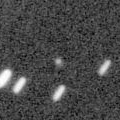
|
Now it is 17.1 mag (Feb. 20, ATLAS South Africa). It stays 17 mag for a while. It stays observable in good condition.
Date(TT) R.A. (2000) Decl. Delta r Elong. m1 Best Time(A, h)
Mar. 2 10 41.38 6 58.2 4.826 5.816 177 17.4 0:03 ( 0, 62)
Mar. 9 10 36.68 8 12.9 4.803 5.781 169 17.3 23:26 ( 0, 63)
|

|
Now it is 18.0 mag (Feb. 7, Toshihiko Ikemura, Hirohisa Sato). Fading slowly. It will be fainter than 18 mag in May. In the Northern Hemisphere, it stays observable in good condition. It locates somewhat low in the Southern Hemisphere.
Date(TT) R.A. (2000) Decl. Delta r Elong. m1 Best Time(A, h)
Mar. 2 6 47.80 21 21.9 1.779 2.426 119 17.4 20:06 ( 0, 76)
Mar. 9 6 51.15 21 57.8 1.849 2.419 113 17.4 19:42 ( 0, 77)
|
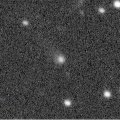
|
Now it is 17.6 mag (Feb. 5, ATLAS South Africa). It stays 18 mag for a while. In the Northern Hemisphere, it will never be observable after this. In the Southern Hemisphere, it stays observable in good condition.
Date(TT) R.A. (2000) Decl. Delta r Elong. m1 Best Time(A, h)
Mar. 2 4 37.85 -67 42.8 3.965 3.951 81 17.5 19:20 ( 8,-14)
Mar. 9 4 28.54 -66 17.1 4.007 3.973 80 17.6 19:26 ( 13,-14)
|

|
Now it is 17.5 mag (Feb. 9, Jean-Claude Merlin). It stays 17 mag for a while. In the Northern Hemisphere, it will be unobservable soon. In the Southern Hemisphere, it stays observable in good condition. It stays 15 mag for a long time from late 2024 to early 2026.
Date(TT) R.A. (2000) Decl. Delta r Elong. m1 Best Time(A, h)
Mar. 2 6 3.58 -55 34.6 5.378 5.535 93 17.6 19:21 ( 0, 0)
Mar. 9 6 2.02 -53 46.2 5.357 5.496 92 17.5 19:26 ( 5, 1)
|
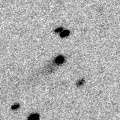
|
Now it is 17.7 mag (Feb. 18, Ken-ichi Kadota). It stays 18 mag for a while. It stays observable in good condition.
Date(TT) R.A. (2000) Decl. Delta r Elong. m1 Best Time(A, h)
Mar. 2 12 5.37 18 58.8 8.533 9.463 158 17.6 1:26 ( 0, 74)
Mar. 9 12 0.99 19 31.1 8.530 9.478 161 17.6 0:55 ( 0, 74)
|
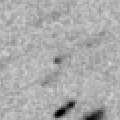
|
Now it is 18.3 mag (Feb. 12, Toshihiko Ikemura, Hirohisa Sato). It will fade out rapidly after this. It will be fainter than 18 mag soon. It stays observable in good condition.
Date(TT) R.A. (2000) Decl. Delta r Elong. m1 Best Time(A, h)
Mar. 2 12 8.03 1 25.3 1.212 2.171 160 17.6 1:29 ( 0, 56)
Mar. 9 12 2.99 1 12.6 1.201 2.182 168 17.6 0:57 ( 0, 56)
|

|
It stays 17 mag for a while. It stays observable in good condition.
Date(TT) R.A. (2000) Decl. Delta r Elong. m1 Best Time(A, h)
Mar. 2 15 26.81 -11 41.9 2.485 2.961 109 18.0 4:47 ( 0, 43)
Mar. 9 15 30.38 -11 10.5 2.388 2.952 115 17.8 4:23 ( 0, 44)
|

|
It approached to Earth down to 0.29 a.u. in early last February, and it brightened up to 4.5 mag (Feb. 1, Juan Jose Gonzalez). Now it is 17.7 mag (Feb. 7, Thomas Lehmann). Fading slowly. It will be fainter than 18 mag soon. In the Northern Hemisphere, it will never be observable after this. In the Southern Hemisphere, it will be getting lower gradually.
Date(TT) R.A. (2000) Decl. Delta r Elong. m1 Best Time(A, h)
Mar. 2 3 1.57 -51 16.3 5.529 5.228 67 17.9 19:20 ( 27, -5)
Mar. 9 3 3.53 -50 20.5 5.626 5.294 65 18.0 19:26 ( 31, -7)
|
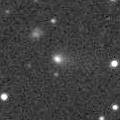
|
Now it is 17.2 mag (Feb. 11, ATLAS Chile). Fading slowly. In the Northern Hemisphere, it will be getting lower gradually. It locates somewhat low in the Southern Hemisphere.
Date(TT) R.A. (2000) Decl. Delta r Elong. m1 Best Time(A, h)
Mar. 2 3 45.46 10 25.8 3.491 3.375 75 17.9 19:20 ( 60, 51)
Mar. 9 3 52.03 11 6.6 3.602 3.392 69 18.0 19:26 ( 67, 46)
|

|
Now it is 17.2 mag (Feb. 11, ATLAS South Africa). Fading gradually. It locates somewhat low in the Northern Hemisphere. In the Southern Hemisphere, it stays observable in good condition.
Date(TT) R.A. (2000) Decl. Delta r Elong. m1 Best Time(A, h)
Mar. 2 7 49.30 -35 55.1 1.845 2.484 119 17.9 21:05 ( 0, 19)
Mar. 9 7 31.31 -35 9.1 1.959 2.528 113 18.1 20:20 ( 0, 20)
|
|
![]()
 C/2019 E3 ( ATLAS )
C/2019 E3 ( ATLAS ) C/2022 U3 ( Bok )
C/2022 U3 ( Bok ) 30P/Reinmuth 1
30P/Reinmuth 1 C/2022 R6 ( PanSTARRS )
C/2022 R6 ( PanSTARRS ) C/2021 S4 ( Tsuchinshan )
C/2021 S4 ( Tsuchinshan ) 471P/2023 KF3
471P/2023 KF3 299P/Catalina-PanSTARRS
299P/Catalina-PanSTARRS C/2023 K1 ( ATLAS )
C/2023 K1 ( ATLAS ) C/2023 T3 ( Fuls )
C/2023 T3 ( Fuls ) C/2023 H5 ( Lemmon )
C/2023 H5 ( Lemmon ) 478P/2023 Y3 ( ATLAS )
478P/2023 Y3 ( ATLAS ) C/2022 A3 ( Lemmon-ATLAS )
C/2022 A3 ( Lemmon-ATLAS ) C/2024 A1 ( ATLAS )
C/2024 A1 ( ATLAS ) C/2020 F2 ( ATLAS )
C/2020 F2 ( ATLAS ) 216P/LINEAR
216P/LINEAR 362P/(457175) 2008 GO98
362P/(457175) 2008 GO98 C/2022 E3 ( ZTF )
C/2022 E3 ( ZTF ) 170P/Christensen
170P/Christensen C/2022 V2 ( Lemmon )
C/2022 V2 ( Lemmon )![]()


























































